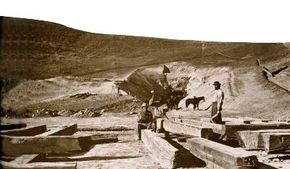Early Mexican Railroads
Neither the culture nor the economy of Mexico favored the development of railroads, nor was the dry, mountainous country hospitable to the iron horse. The country's first attempt at railroad building began in the mid-1840s; 40 years later, less than 400 miles of track were in service. Mexican President Porfirio Diaz set out to change that in 1880, offering concessions to U.S. companies willing to fund and build Mexican railroads. Over the next few decades, rail lines gradually radiated from Mexico City to connect interior points with the U.S. railroad network at Nogales, Arizona, and the Texas towns of Laredo and El Paso.
Many Mexican railroads were in fact controlled by American and British companies, which operated them primarily for north-south commerce. In the traditional agrarian economy of Mexico, railroads did not have the same transforming effect that the railroads of the north did. Only in the twentieth century would Mexico's railroad network come into its own as a genuine national system.
Advertisement
